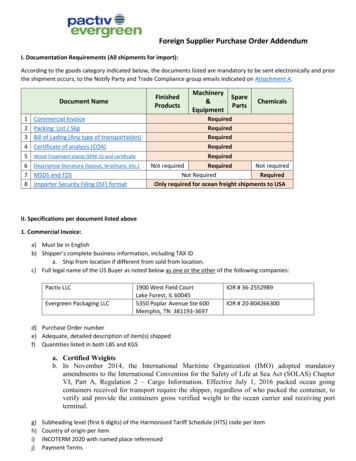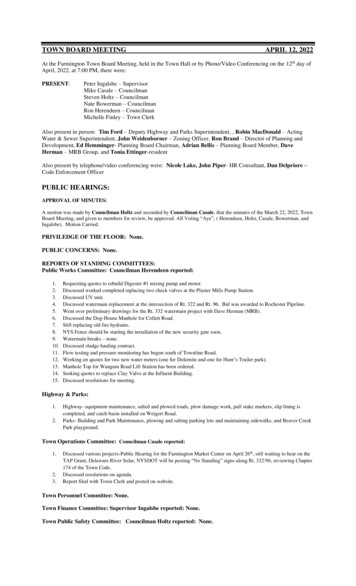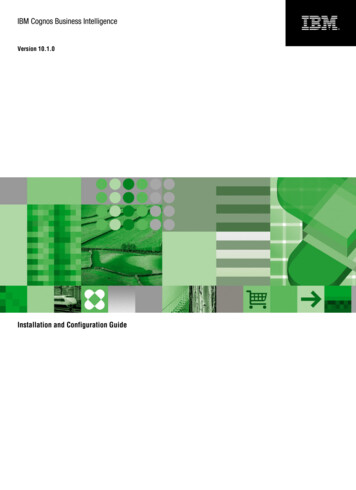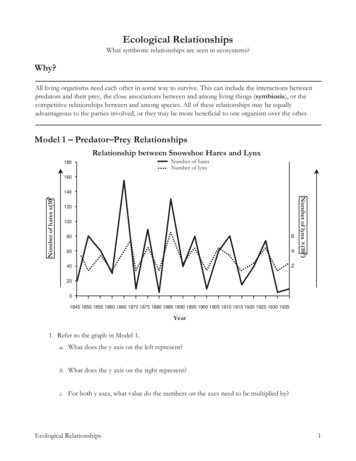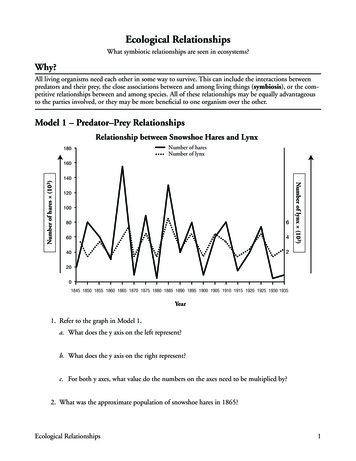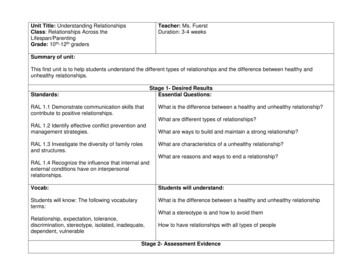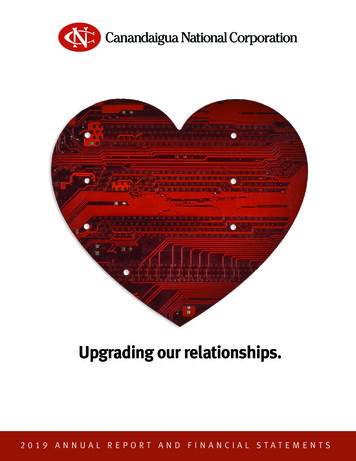
Transcription
Upgrading our relationships.2019 ANN UAL REPORT AND FI NANCIAL STATE MENTS
Technology is at its bestwhen it benefits people.What does technology have to do with relationships? Today, plenty.Customers expect technology to make every aspect of their lives easier and more convenient,including banking. That’s why we continue to explore, identify, and implement technology that helpsus deliver an exceptional banking and customer service experience across all channels.We also believe in the personal connection and that our bank office locations enable us to buildnew relationships and better serve our communities. This delicate balance between “high-tech” and“high-touch” allows us to execute on our community banking model—which is at the heartof everything we do and has proven effective in any financial climate.We’re grateful to our shareholders for their continued faith in this model, to our colleagueswho execute it flawlessly, and to our customers who it has served so well since 1887.
February 12, 2020A message fromFrank H. Hamlin, III,President and CEODear Shareholders,2019 was another highly profitable and overall financially successful year. On a reported basis, net income anddiluted earnings per share increased by 9% to 39.2 million and 20.77, respectively, compared to 2018. On anadjusted basis, to provide a comparison of core earnings, the increases rise to 21%. While there were nosignificant non-core income or expenses during 2019, the 2018 adjusted results exclude the 4.6 millionnon-recurring gain on sale of USA Payrolls, Inc., that was discussed in last year’s letter. Return on average assetsfor 2019 was 1.33%, while return on average equity was 15.73%.Net interest income is a material driver of our financial performance. Four increases in the federal fundsinterest rate during 2018, totaling 100 basis points (1.00%), had a positive impact on interest income during 2018and the first portion of 2019. Increases to interest expense (associated with interest-bearing deposit accountsand borrowings) were more moderate during this same period, which amplified the increases in net interestincome. Of course, as luck would have it, just as the lag in increases to interest expense was catching up and, to alarge extent, locked in for the remainder of 2019, we experienced three 25 basis point (0.25%) decreases of thefederal funds interest rate throughout the middle and end of the year. These decreases were unexpected andunplanned going into 2019 when the consensus amongst economic analysts was that the federal funds rate wouldundergo between two and four 25 basis point increases for the year. The positive impacts to net interest incomeexperienced during the first half of the year were offset by negative impacts during the second half of the year.However, when all the dust settled, net interest income still increased during 2019 by approximately 8%,compared to 2018, and surpassed 100 million for the first time in our history.Loan growth was nearly 6% during 2019. Commercial loans and residential mortgage loans each increasedapproximately 7%, while consumer loans (primarily auto) increased 2%. We intentionally held back on theproduction of auto loans to redeploy assets into higher yielding commercial loans. That is not to discount theefforts of the indirect lending department, as obtaining a 2% increase requires a high level of new loanoriginations, given this portfolio experiences one of the highest loan turnover (runoff) of CNC’s loan portfolios.Credit quality remains exceptional across the loan portfolios.On the other side of the balance sheet, total deposits increased by nearly 7%. Although the mix of thesedeposits leaned a bit heavier toward more expensive interest-bearing time deposits, this growth more thansupported loan growth for the year. The entire industry has been scrambling for low-cost deposits as loan-todeposit ratios have steadily increased. The sustained increase in our deposits year after year is the direct resultof our branch employees. Give them a high five when you see them!Our Wealth area ended the year strong despite starting 2019 in a significantly down market. Book value ofassets under administration increased nearly 10%, which is fantastic. The increase or decrease of book value isimportant as it more closely reflects the change in assets under administration as a function of production
activities instead of market movement. Nonetheless, the nearly 21% increase experienced in market value ofassets under administration is important as this is the basis for deriving revenues, which increased 6% to 21.5million for the year.On the legislative front, the credit union industry tried yet again to push legislation allowing them to receivemunicipal deposits. For the first time that I can remember, a public hearing was held in Albany where proponentson both sides of the issue testified before the State Legislature. Our very own Director, Larry HeilbronnerKolthoff, testified on behalf of the Independent Bankers Association of New York, among others, against theinitiative. Credit unions do not pay income tax, yet expect to hold and leverage those same tax proceeds to whichthey do not materially contribute. Credit unions have fought quite hard not to be held accountable to theCommunity Reinvestment Act (CRA), to which banks are accountable. The CRA relates directly to the efforts offinancial institutions to serve low to moderate income individuals in their footprint. It is the service of those veryindividuals which credit unions try to justify their continued corporate welfare, yet they are held unaccountablefor such activities. To add further insult to injury, credit unions shelter income from their investmentmanagement businesses and other “related activities,” which most certainly are not intended to service the lowto moderate income demographic. The tone of discussion is beginning to shift as legislators begin to understandthat credit unions’ “not-for-profit” tax treatment is being conveyed without reporting executive income, nor arecredit unions providing a product or service to demographics not otherwise being served by those who pay taxes.It truly is time for credit union corporate welfare to end.Also, we have been closely watching the marijuana debate at both federal and state levels. More thantwo-thirds of states currently allow for the production and use of medical marijuana despite the FederalGovernment’s strict prohibition of marijuana. Currently, New York shares all its borders with states that allowmedical marijuana. Both Vermont and Massachusetts have legalized marijuana’s recreational use, as has thecountry of Canada! Federal legislators still have not figured out there is a problem here. It is clear that marijuanafails the definition of a drug that has no medical benefit. Marijuana laws throughout the country have beendisproportionately enforced and used as a pretext to harass (stop and frisk) a disproportionately highpercentage of non-Caucasian citizens. Nonetheless, the Federal Legislature spent its time creating a carve-outfor the production and sale of hemp (hemp is marijuana with less than .3% of tetrahydrocannabinol (“THC”) bydry weight whereas recreational marijuana contains 2%-4% of THC by dry weight). For banks, this means we cannow legally take deposits derived from the production and sale of hemp-based products without being a party tofederal money laundering. However, federal financial institutions are still strictly prohibited from doing businesswith individuals and businesses who derive proceeds from the sale of medical and recreational marijuana. Thishas resulted in huge amounts of cash circulating outside of the banking system, especially in states wheremarijuana is legal for recreational use. Ironically, the IRS accepts tax revenue from businesses in legalizedmarijuana states based upon gross revenue, not net; therefore, the IRS “money launders” prohibited Schedule 1drug proceeds! Please reach out to your federal representatives and encourage them to declassify cannabis as aSchedule 1 drug. Enough damage has been done by this failed public policy.The deadline for implementation of the Current Expected Credit Losses (CECL) allowance for loan-lossstandard again was delayed or postponed until January 1, 2023, for institutions of our size. This has become anenormously time-consuming issue which we expect to have little effect on the amount held in our allowance.
From a practical standpoint, the industry will end up running two systems for at least a year in order to validatethe new CECL accounting standard and still ensure prudent provisioning. The longer we can put off implementingthe CECL standards, the clearer “proper” implementation should be defined by the Financial AccountingStandards Board (FASB). The largest financial institutions are currently implementing the standard without fullyunderstanding the effects upon earnings and capital. There is currently bipartisan support for analysis of thisaccounting standard and its potential effect on the industry, which will likely result in further modifications of thestandard as applied to community banks. We will continue to monitor CECL developments as they apply to ourorganization.Throughout 2019, we analyzed our processes and workflows throughout the entire organization. There are asurprising number of manual processes occurring in order to perform some of the day-to-day activities of theinstitution. Although this is common in mature companies in mature industries, it can eventually become animpediment to meeting customer expectations and therefore hurt growth. In 2019, we set the stage andcommenced execution of a multiyear plan to significantly upgrade our technical and process infrastructure. Thisis necessary for enhanced quality control, scalability, and control over the ultimate customer experience. Throughthe assistance of external resources, we expect to glide through implementation of the requisite changes in aphased approach. As we progress, we will be in a position to retire a number of legacy systems that are redundantor fail to integrate effectively with our technology infrastructure in its future state.In 2011, we purchased Online Brokerage Services (OBS), a registered investment advisor, from a failedcredit union in Texas. We had previously used OBS to gain access to Dimensional Funds Advisor (DFA) portfolios,which we had identified as a high-quality enhanced index investment solution for our customers. The purchase ofOBS was a tactical decision to preserve our conduit to DFA. OBS also acted as a Turnkey Asset ManagementProgram (TAMP) for smaller banks and credit unions who wanted to provide investment solutions to their clientsbut were not of a size to handle the technical and/or governance structures necessary to do so in-house. Thus,OBS could be leveraged to produce assets under management from areas outside our geographic footprint. Thisstrategy served us well for the last nine years; however, due to changes in market factors and a desire to focusmore intently on our local strategic mission, we opted to divest this business. Throughout 2019 we haddiscussions with several suitors, eventually entering into contract with purchaser AssetMark Financial, Inc. Coreto this arrangement is to protect and enhance our customers’ experience during and after this transition. Inshort, the sale of OBS will not affect our local customer base, although internal adjustments are being made toaccommodate the change. We expect the transaction to close in the first quarter of 2020 or shortly thereafter.While we expect a gain on sale of OBS to be recorded during 2020, recurring net income will not be impacted in asignificant manner after this divestiture. Additionally, the 3.7 billion we report as assets under administrationwill not be impacted, as the assets OBS manages are not included in this figure.In Brockport, we broke ground for construction of our newest branch location in May 2019. The site is locatedadjacent to the Brockport Wegmans store on the corner of Routes 31 and 19. We anticipate opening this newlocation for business in the Spring and are greatly encouraged by the positive reception in the community. Theselection of this site is a result of understanding where our customers live, work, and play, and then providing aphysical location for them to transact business if they so choose. Please keep your eye open for upcomingannouncements as we get closer to our opening date!
In 2019, we planned for the retirement of our Chief Lending Officer and head of Commercial Services, GaryBabbitt. Mr. Babbitt joined CNC in 1996 as a Commercial Lender and transitioned into the role of head ofCommercial Services in 2006 and was named Executive Vice President in 2008. As such, he was responsible forlending decisions across all lines of business, as well as Resource Recovery activities. It should be recognizedthat Mr. Babbitt’s tenure spanned the most significant economic downturn experienced since the GreatDepression. Our success throughout the Great Recession can be directly attributed to Gary’s impeccablejudgment and steady hand. The years following the Great Recession presented industry-wide credit qualitychallenges and margin compression. Our credit quality experience was significantly better than our peers, whichmaterially contributed to our ability to increase earnings and grow while others failed.To retain Mr. Babbitt’s judgment and experience while allowing him to retire, he was appointed a position onthe Board of Directors in December 2018. Throughout 2019, Mr. Babbitt worked with his teams to transition rolesand responsibilities. Thus, as of January 1, 2020, Charlie Vita succeeded Gary’s role as Chief Lending Officer andExecutive Vice President. Mr. Vita joined CNC in 2011 as a Commercial Lender with 17 years of bankingexperience. Michael Mallaber, who joined CNC in 1999 as a Commercial Lender, has taken on the role of Directorof Commercial Services. We are very excited to leverage the energy and experience of both Mr. Vita and Mr.Mallaber while continuing to enjoy Gary Babbitt’s contributions as a member of the Board of Directors.It is with great sadness that I disclose the loss of our friend and Director, Richard Fox, who passed away onDecember 4, 2019. Mr. Fox joined our Board in 2008 in connection with the acquisition of Genesee Valley TrustCompany. He brought in-depth business experience, common sense, and a deep understanding of the communityto the Board. His quiet-spoken yet direct nature made him an ideal mentor. He will be sorely missed.On a happier note, in November 2019, Dr. James Watters joined the Board of Directors. Dr. Watters currentlyserves as Senior Vice President and Treasurer, Finance and Administration, at Rochester Institute of Technology(RIT). At RIT, he is responsible for the direct investment of 250 million of working capital, the administration ofthe investment process for 948 million of endowment assets–which includes overseeing approval for 10 realestate funds–and the management and issuance of 405 million of public debt. In his senior leadership role, Dr.Watters manages more than 870 staff charged with responsibility for the financial, physical, human capital, andinformation assets of RIT.In that capacity, Dr. Watters oversees Information Technology and Security of RIT and brings a wealth ofrelated experience not currently represented on our Board. As we navigate future technology and data securitychallenges, Dr. Watters’ experience and insight will be valuable assets.Thank you for your continued faith in our community banking model and our people who executethis model flawlessly!Yours,Frank H. Hamlin, IIIPresident and CEO
CNC Shareholder RelationsCanandaigua National Corporation (CNC) is the holding company for TheCanandaigua National Bank & Trust Company and Canandaigua National TrustCompany of Florida. In combination, these companies and their subsidiaries providea full range of financial services, including banking, trust, investment management,and insurance services to individuals, corporations, and municipalities.Canandaigua National Bank & Trust is an independent community bank, and amember of the FDIC. CNC stock is not traded on an exchange like other Wall Streetstocks, but in auctions based on purchase and sale bids submitted in a sealed-bidprocess.Consistent with our strategy as a community bank, we make decisions locally – basedsolely on what’s best for our valued customers, the communities we serve, ouremployees, and our shareholders.Scott B. TrumbowerSenior Vice PresidentDirector of Shareholder Relations(585) 419-0670 x 50611STrumbower@CNBank.comAs one of CNC’s constituents, shareholders are an important part of our pastsuccess and bright future. Many of our shareholders are also colleagues, communitymembers and customers who have been a part of the CNC family for generations.Shareholder Relations TeamThe Shareholder Relations Team is dedicated to assisting current and prospectiveShareholders with inquiries and a variety of shareholder-related activities. Thesemay include buying, selling, and gifting shares; tax cost basis research; dividendpayment details; updating contact information; and all general CNC questions.Shareholder Relations is located on the first floor of the Canandaigua National Bank& Trust Main Office in the Wealth Management Suite at 72 South Main Street,Canandaigua, NY 14424.Kirsten JohnsonShareholder Relations Specialist(585) 419-0670 x 36067KJohnson@CNBank.comShareholder InformationFor additional shareholder information, please visit: t B. TrumbowerKirsten Johnson
CANANDAIGUA NATIONAL CORPORATION72 South Main StreetCanandaigua, New York 14424Phone: 585-394-42601-800-724-2621Fax: 585-394-4001Internet: www.cnbank.com2019 Annual ReportTable of ContentsPAGEFinancial Highlights2Our Common Stock3Audited Financial StatementsIndependent Auditors’ Report4Consolidated balance sheets at December 31, 2019 and December 31, 20185Consolidated statements of income for the years endedDecember 31, 2019 and 2018.6Consolidated statements of comprehensive income for the years endedDecember 31, 2019 and 2018.7Consolidated statements of stockholders' equity for the years endedDecember 31, 2019 and 2018.8Consolidated statements of cash flows for the years endedDecember 31, 2019 and 2018.9Notes to consolidated financial statements10Annual MeetingThe Annual Meeting of Shareholders of Canandaigua National Corporation (the Company) will be held at the Main Office ofThe Canandaigua National Bank and Trust Company, 72 South Main Street, Canandaigua, NY, 14424; Wednesday, April29, 2020, at 1:00 p.m.
Presented below is a summary of selected financial highlights to display a snapshot of our performance for the past five years.Balance sheet information is as of the year end, while income statement and average balance information is for the full-yearperiod. This and all information concerning our financial performance should be read in conjunction with the ConsolidatedFinancial Statements and Notes thereto.Financial Highlights(Dollars in thousands except per share data)Income Statement Information:Net interest incomeProvision for loan lossesNon-interest income (1)Operating expensesIncome taxes (2)Net income attributable to CNCBalance Sheet Data - Period End:Investments (3)Loans, netAssetsDepositsBorrowingsEquityBalance Sheet Data - Average:Investments (3)Loans, netAssetsDepositsBorrowingsEquityAsset Under Administration: (4)Book value (cost basis)Market valuePer Share Data:Net income, basicNet income, dilutedCash dividendsBook ValueClosing stock price (5)Weighted average shares - dilutedOther ratios:Return on average assetsReturn on average equityReturn on beginning equityDividend payoutAverage equity to average assetsNet interest marginEfficiency (6)Employees (year end)TotalFTE's2019% Change2018201720162015 100,4266,85051,48194,47211,40239,1787.6 %(11.9)%(1.7)%2.9 %12.6 %9.1 22,48872,8525,69539,83675,20910,79321,064 .0)%5.8 %5.4 %6.6 %(18.1)%13.8 431,824,7612,271,5091,815,383197,100183,606 0 %6.4 %6.7 %7.6 %(6.3)%13.7 711,765,5002,199,1741,780,577167,949174,399 2,990,9443,690,2049.8 %20.8 7,5062,282,9522,576,610 9.2 %9.5 %18.8 %13.9 %9.0 .791,899,20611.1811.053.6996.77148.721,907,0712.3 %(4.1)%(2.9)%8.4 %6.6 %1.1 %(0.6)%1.3016.4017.2725.317.913.5862.432.9 %4.0 .8911.3337.147.813.4464.01%%%%%%%541500(1) 2018 includes a 4.6 million gain on sale attributable to the minority ownership interest we previously held in USA Payrolls, Inc.(2) Negatively impacted 2017 by a 3.7 million one-time non-cash write-down of net deferred tax assets upon the December 2017 enactment of the“Tax Cuts and Jobs Act of 2017”, which reduced the statutory federal income tax rate to 21% from 35%. The lower tax rate positively impacted 2018.(3) Includes the Company's investment in Federal Reserve Bank stock and Federal Home Loan Bank stock.(4) These assets are held in a fiduciary or agency capacity for clients and are not included in our balance sheet.(5) Price is based upon last sealed-bid auction of the respective year, administered by the Bank’s Trust Department.(6) Operating expenses, exclusive of intangible amortization, divided by total %
Our Common StockInformation about beneficial ownership of the Company's stock by directors and certain officers is set forth in the Company’sProxy Statement for the Annual Meeting of Shareholders. Market value and dividend information is set forth in the table below.The Company currently pays a semi-annual dividend in February and August. We expect to continue to pay cash dividendsto our stockholders for the foreseeable future.While the Company's stock is not actively traded, from time to time, shareholders sell shares to interested persons in sealedbid public auctions administered by the Company’s Trust Department at the request of selling shareholders. Our stock is notlisted with a national securities exchange. Due to the limited number of transactions, the quarterly high, low and weightedaverage sale prices may not be indicative of the actual market value of the Company's stock. The following table sets forth asummary of transactions by selling shareholders and bidders in the Company's common stock during each period fortransactions that were administered by the Company’s Trust Department. Also included are the book value at quarter end,and semi-annual dividends paid per share since the first quarter of 2015.#SharesSoldQuarterlyAverageSales PriceQuarterlyHighSales PriceQuarterlyLowSales )DividendPaid20194th Quarter3rd Quarter2nd Quarter1st Quarter3,6678,8514,5554,800 5.485.775.303.002.7020184th Quarter3rd Quarter2nd Quarter1st Quarter3,2753,8503,8116,603 6.254.454.582.502.3020174th Quarter3rd Quarter2nd Quarter1st Quarter5,1203,0444,4092,188 3.483.083.232.302.0020164th Quarter3rd Quarter2nd Quarter1st Quarter6,9552,2315,9961,439 .123.072.701.951.9220154th Quarter3rd Quarter2nd Quarter1st Quarter3,6731,8805,7042,809 2.961.761.861.8333
CANANDAIGUA NATIONAL CORPORATION AND SUBSIDIARIESCONSOLIDATED BALANCE SHEETSDecember 31, 2019 and 2018(dollars in thousands, except share data)Independent Auditors’ ReportThe Board of Directors and StockholdersCanandaigua National Corporation:Report on the Financial StatementsWe have audited the accompanying financial statements of Canandaigua National Corporation, which comprise the consolidated balance sheetas of December 31, 2019, and the related consolidated statements of income, comprehensive income, changes in stockholders’ equity, and cashflows for the year then ended, and the related notes to the consolidated financial statements.Management’s Responsibility for the Financial StatementsManagement is responsible for the preparation and fair presentation of these financial statements in accordance with accounting principlesgenerally accepted in the United States of America; this includes the design, implementation, and maintenance of internal control relevant to thepreparation and fair presentation of financial statements that are free from material misstatement, whether due to fraud or error.Auditors’ ResponsibilityOur responsibility is to express an opinion on these financial statements based on our audit. We conducted our audit in accordance with auditingstandards generally accepted in the United States of America. Those standards require that we plan and perform the audit to obtain reasonableassurance about whether the financial statements are free from material misstatement.An audit involves performing procedures to obtain audit evidence about the amounts and disclosures in the consolidated financial statements.The procedures selected depend on the auditor’s judgment, including the assessment of the risks of material misstatement of the consolidatedfinancial statements, whether due to fraud or error. In making those risk assessments, the auditor considers internal control relevant to the entity’spreparation and fair presentation of the consolidated financial statements in order to design audit procedures that are appropriate in thecircumstances. An audit also includes evaluating the appropriateness of accounting policies used and the reasonableness of significantaccounting estimates made by management, as well as evaluating the overall presentation of the consolidated financial statements.We believe that the audit evidence we have obtained is sufficient and appropriate to provide a basis for our audit opinion.OpinionIn our opinion, the financial statements referred to above present fairly, in all material respects, the financial position of Canandaigua NationalCorporation as of December 31, 2019, and the results of its operations and its cash flows for the year then ended in accordance with accountingprinciples generally accepted in the United States of America.Report on Internal Control over Financial ReportingWe also have audited in accordance with auditing standards generally accepted in the United States of America, Canandaigua NationalCorporation's internal control over financial reporting as of December 31, 2019, based on criteria established in the Internal Control – IntegratedFramework (2013) issued by the Committee of Sponsoring Organizations of the Treadway Commission (COSO) relevant to reporting objectivesfor the express purpose of meeting the regulatory requirements of Section 112 of the Federal Deposit Insurance Corporation Improvement Act(FDICIA)” and our report dated February 26, 2020 expressed an unmodified opinion.Other MatterThe financial statements of Canandaigua National Corporation as of December 31, 2018 were audited by other auditors whose report datedMarch 4, 2019, expressed an unmodified opinion on those statements.Crowe LLPLivingston, New JerseyFebruary 27, 2020See accompanying notes to consolidated financial statements.44
CANANDAIGUA NATIONAL CORPORATION AND SUBSIDIARIESCONSOLIDATED BALANCE SHEETSDecember 31, 2019 and 2018(dollars in thousands, except share data)AssetsCash and due from banksInterest-bearing deposits with other financial institutionsof which 1,682 and 461 respectively, is restrictedFederal funds soldSecurities:- Debt, Available for sale, at fair value- Debt, Held-to-maturity (fair value of 24,475 and 55,227, respectively)- Equity, at fair valueLoans held for sale, at lower of cost or fair valueLoans, grossAllowance for loan lossesLoans - netPremises and equipment – netAccrued interest receivableFederal Home Loan Bank stock and Federal Reserve Bank stockGoodwillIntangible assets – netOther assetsTotal AssetsLiabilities and Stockholders' EquityDeposits:DemandNon-interest bearingInterest bearingSavings and money marketTimeTotal depositsBorrowingsJunior subordinated debenturesAccrued interest payable and other liabilitiesTotal Liabilities2019 Equity:Canandaigua National Corporation stockholders' equity:Preferred stock, .01 par value; 4,000,000 sharesauthorized, no shares issued or outstandingCommon stock, 5.00 par value; 16,000,000 sharesauthorized, 1,946,496 shares issuedAdditional paid-in-capitalRetained earningsTreasury stock, at cost (76,246 shares and75,387 shares, respectively)Accumulated other comprehensive income (loss), netTotal Canandaigua National Corporation Stockholders' EquityNoncontrolling interestsTotal Stockholders' EquityTotal Liabilities and Stockholders' Equity ,57043551,1413,015,665343,19955,2778,7173,1
OBS was a tactical decision to preserve our conduit to DFA. OBS also acted as a Turnkey Asset Management Program (TAMP) for smaller banks and credit unions who wanted to provide investment solutions to their clients but were not of a size to handle the technical and/or governance structures necessary to do so in-house. Thus,
